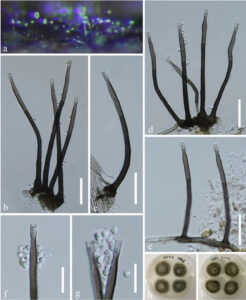Chaetosphaeria polygonalis J. Yang, Jian K. Liu & K.D. Hyde, in Yang, Liu, Jones, Hyde, Liu, Bao, Liu, Li, Shen, Yu & Liu, Fungal Diversity 119: 114 (2023)
MycoBank number: MB 559650; Index Fungorum number: IF 559650; Facesoffungi number: FoF 12807;
Etymology – referring to the polygonal conidia.
Holotype – HKAS 112570
Saprobic on decaying twig in a freshwater stream. Asexual morph: Colonies on wood effuse, hairy, scattered, or aggregated, dark brown, with glistening masses of conidia at the apex. Conidiophores macronematous, mononematous, erect, straight, or slightly flexuous, solitary or aggregated in small groups, cylindrical, smooth, 3–6-septate, unbranched, dark brown, paler at the apical cell, 50–100 × 2.2–3.3 µm ( = 78.5 × 2.8 µm, n = 25), sometimes arising from creeping hyphae. Conidiogenous cells monophialidic, integrated, terminal, determinate, brown, 24.5–39 × 2.4–3.4 µm ( = 28.3 × 2.9 µm, n = 20), pale brown to subhyaline at the cup-like collarette 2–3 µm wide, 4.4–6.4 µm high. Conidia acrogenous, aggregated in slimy masses, cuneiform, aseptate, smooth, hyaline, 1.4–2.4 × 1.2–1.8 µm ( = 1.8 × 1.4 µm, n = 25). Sexual morph: Undetermined.
Culture characteristics – Conidia germinating on WA medium within 24 h. Colonies on PDA medium reaching 10–15 mm diam. after 2 weeks at 25 °C in dark, with dense grayish brown mycelium in the middle, paler and sparser towards the edge; in reverse white and grayish green in the middle, dark brown in the inner ring and paler at the entire margin.
Material examined – CHINA, Guizhou Province, Dushan District, 25.965° N, 107.65° E, on decaying wood submerged in a freshwater stream, 6 July 2018, J. Yang, SGT1-2 (HKAS 112570, holotype), ex-type cultures MFLUCC 19-0259 and GZCC 20-0438.
Notes – Chaetosphaeria polygonalis was placed as a sister taxon to C. guttulata. However, they are significantly different in morphology. Chaetosphaeria polygonalis has monophialidic conidiogenous cells and cuneiform, aseptate conidia, while C. guttulata has polyblastic conidiogenous cells bearing many tiny protuberant conidiogenous loci and ovoid or fusiform, 3-septate conidia (Luo et al. 2019). Comparisons of the ITS, LSU, SSU, and RPB2 sequences of C. polygonalis and C. guttulata showed 99.58% (472/474 bp), 99.87% (752/753 bp), 100% (886/886 bp), 98.86% (958/969 bp) sequence similarity, respectively. Their TEF1α sequence revealed a low similarity at 89.62% (656/732 bp). We treat C. polygonalis as a distinct species from C. guttulata in the polyphyletic genus Chaetosphaeria.

Figure 1. Chaetosphaeria polygonalis (HKAS 112570, holotype). a Colony on woody substrates. b–e Conidiophores with conidia. f, g Conidiogenous cells and Conidia. h, i Culture, h from above, i from below. Scale bars: b–e = 20 μm, f, g = 10 μm.
